Blaxploitation Education: Slaughter's Big Rip-Off!
The rare Blaxploitation sequel that's better than the original.
Slaughter’s Big Rip-Off!
Written by Charles Eric Johnson and Doug Williams
Directed by Gordon Douglas
1973
By 1973, the Blaxploitation genre didn’t have a very good track record when it came to sequels. Of the two Shaft sequels, Shaft’s Big Score! was decent but a significant decline in quality from the original, and Shaft in Africa continued that trend. While Blacula wasn’t amazing, its sequel didn’t even measure up to the low bar it had set. And the less said about Super Fly T.N.T., the better. So color me surprised that the sequel to the cheap action movie Slaughter actually improved on its predecessor, serving as another good vehicle for Jim Brown that situates him squarely within the urban setting where the best Blaxploitation stories take place. It’s a step up from the rudimentary plot of the first movie, which sent Brown to Mexico to battle some mafia types with poorly-defined motives.
Slaughter’s Big Rip-Off!, which has a title that itself seems like a rip-off of Shaft’s Big Score!, doesn’t have the cool theme song of the original, but it does have a score by James Brown, which provides an underlying sense of excitement and driving energy throughout. It opens with Slaughter at a picnic hosted by some rich white guy, with everybody celebrating after a friendly horse race. But they’re interrupted when a biplane flying nearby suddenly wheels around and starts strafing the picnic, killing both the host and a pal of Slaughter’s who was in attendance.
It turns out this is revenge from the mafia after Slaughter ruined their computer-based schemes in Mexico. The head of the Los Angeles chapter of the mafia is Duncan, played by Ed McMahon(!), and he’s pissed that Harry, the guy who was supposed to carry out the hit on Slaughter, failed in such a spectacular and newsworthy way. While in the middle of a pool party at his mansion, Duncan upbraids his minion for his failure, and then he introduces him to a new enforcer, Kirk (Don Stroud), who kills the guy with a pool floatie as soon as everyone else clears out.
Meanwhile, Slaughter is ready to get out of town, and we see him packing up the suitcase arsenal he used in the last movie to make sure he’ll have protection. He’s stopped by a couple of cops, who want to take him in for questioning. Officer Reynolds (Brock Peters, who wasn’t in as many Blaxploitation movies as he could have been, with his steadfast presence and his distinctive voice that I eventually recognized as belonging to Captain Sisko’s father on Star Trek: Deep Space Nine) thinks Slaughter should be kept off the street, even if he has to arrest him on trumped-up charges, since it’s clear that the mob wants him dead. But he’s stymied by his captain, who shows up and insists that Slaughter should remain free, as long as he stays in town.
With no other options, Slaughter decides to find out who tried to have him killed, leading him to seek out some information from some good-ol-boys at the local airport. When they initially resist his questions and throw in some racial slurs while they’re at it, he beats them up and finds out where Harry is. But when he gets there, he find’s Harry’s dead body, and he’s confronted by Officer Reynolds, who threatens to pin the murder on Slaughter if he doesn’t help him out. He wants Slaughter to break in to the house of a member of the local mafia and steal a list detailing all the payoffs that have been made to local officials, including the captain who insisted that Slaughter stay on the streets, where it will be easier for the mafia to kill him.
Giving this a moment’s thought should make one realize that this doesn’t make a whole lot of sense, both because it would seem pretty dumb for the mafia to keep convenient evidence of bribery and corruption laying around, but also because it would probably be easier to have someone kill Slaughter while he was in prison rather than trying to hunt him down while he has access to plenty of weapons. But this isn’t the kind of movie that’s especially concerned with a realistic depiction of organized crime, so it’s best to just roll with it.
As he proceeds with the eponymous heist, Slaughter will need a safecracker, so he gets an old friend of his (Scatman Crothers!) to point him to a person with those skills. This person turns out to be Joe Creole (Richard Williams, who was also in The Mack and UpTight), a local pimp who had previously tried to get Slaughter to pay him for some information but got the brush-off when he clearly didn’t know anything. He’s a pretty enjoyable, larger-than-life figure, seeming like he could be the inspiration for the types of characters that Charlie Murphy used to play on Chapelle’s Show, always ready with a quip and serving as a nice foil to Jim Brown’s tight-lipped, cool-as-ice hero.
Slaughter and Joe pull off the heist in a scene that plays out kind of like a video game stealth mission in which the player sneaks into a location and gets what they came for, but makes too much noise and ends up having to kill a whole bunch of guards on the way out. It’s somewhat notable in that while Joe is breaking into the safe, Duncan is having sex in the next room (at this point, Slaughter hadn’t yet figured out that he was the boss who had ordered a hit on him), providing viewers with some audio of Ed McMahon in the throes of pleasure that probably disturbed audiences of The Tonight Show at the time. There’s also a nice stunt in which Jim Brown’s double does a flying tackle from a roof in order to save Joe from being shot.
The theft of the incriminating evidence causes the mafia to really step up their efforts to kill Slaughter and anyone associated with him, and Kirk is the one who gets to use the harshest methods as he enacts violence. He ends up murdering Joe, almost killing Officer Reynolds with a sniper rifle, and kidnapping Slaughter’s girlfriend Marcia (Gloria Hendry, from Black Caesar, Across 110th Street, and more Blaxploitation movies to come). He’s this movie’s version of the white thug who takes a lot of pleasure in enacting violence on Black people, and while he’s not as aggressive in his racism as Rip Torn was in the first movie, he still gets to say a few racial slurs, making his eventual comeuppance especially enjoyable.
All of this makes for a pretty enjoyable, exciting plot, especially when Slaughter goes into revenge mode and takes out any of these dumb white gangsters who dared to cross him. Jim Brown is as cool as you would expect, using plenty of weapons to blow these idiots away but also having little trouble punching out anyone who tries to tangle with him hand to hand (there’s one scene in which a middle-aged Asian guy tries to use some karate on him while making a bunch of loud “Haaiii-oohhh!” sounds, which is an early sign of the influence that Chinese martial arts films would have on Blaxploitation). He also gets a couple sex scenes, including one with a white woman who insists on getting some physical payment in return for information. Even though he cares enough about his girlfriend to leave a trail of bodies behind when he’s trying to save/avenge her (notably, he doesn’t reciprocate when she tells him she loves him), he doesn’t have any compunctions about fooling around behind her back. I guess that’s what was expected of sex-machine Blaxploitation heroes.
There’s only a little bit of social commentary here, and some of it may just be fulfillment of expectations about the corruption of the cops and the authorities, who don’t really care all that much if Black people are being killed. In one scene, one of Kirk’s men impersonates a cop in order to kidnap Marcia, and when the guy’s identity is revealed, Kirk informs her and Slaughter that they should never trust a cop. This is treated as a despicable betrayal of trust, but really, it’s nothing they wouldn’t have already expected, given the way cops typically treat Black people in Los Angeles.
While I can’t claim that this is a great movie, it’s a pretty solid mid-tier example of Blaxploitation action. Jim Brown can always be relied on to serve as a steady, badass presence in these types of movies, and he certainly doesn’t disappoint. I also appreciate that while Ed McMahon was a recognizable name, he didn’t try to make himself into an especially fearsome villain, and when the time comes for him to come face to face with Slaughter, he goes out like a pathetic loser. With a plot that serves as a good vehicle for shootouts and fistfights and some memorable characters on both sides of the law, this isn’t bad at all. Fortunately, I don’t think we’ll be getting too many more Blaxploitation sequels, but if we did, this one would have set a pretty good standard for them to follow.
Blaxploitation Education index:
UpTight
Cotton Comes to Harlem
Watermelon Man
The Big Doll House
Shaft
Sweet Sweetback’s Baadasssss Song
Super Fly
Buck and the Preacher
Blacula
Cool Breeze
Melinda
Slaughter
Hammer
Trouble Man
Hit Man
Black Gunn
Bone
Top of the Heap
Across 110th Street
The Legend of N***** Charley
Don’t Play Us Cheap
Shaft’s Big Score!
Non-Blaxploitation: Sounder and Lady Sings the Blues
Trick Baby
The Harder They Come
Black Mama, White Mama
Black Caesar
The Mack
Book of Numbers
Charley One-Eye
Ganja & Hess
Savage!
Coffy
Shaft in Africa
Super Fly T.N.T.
Scream Blacula Scream
Cleopatra Jones
Terminal Island
Gordon’s War




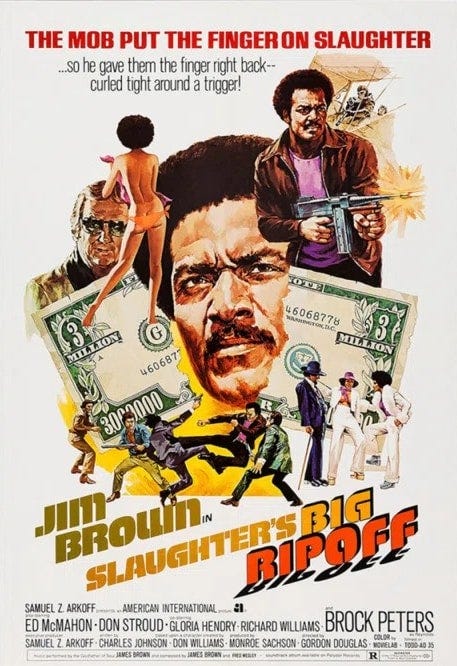
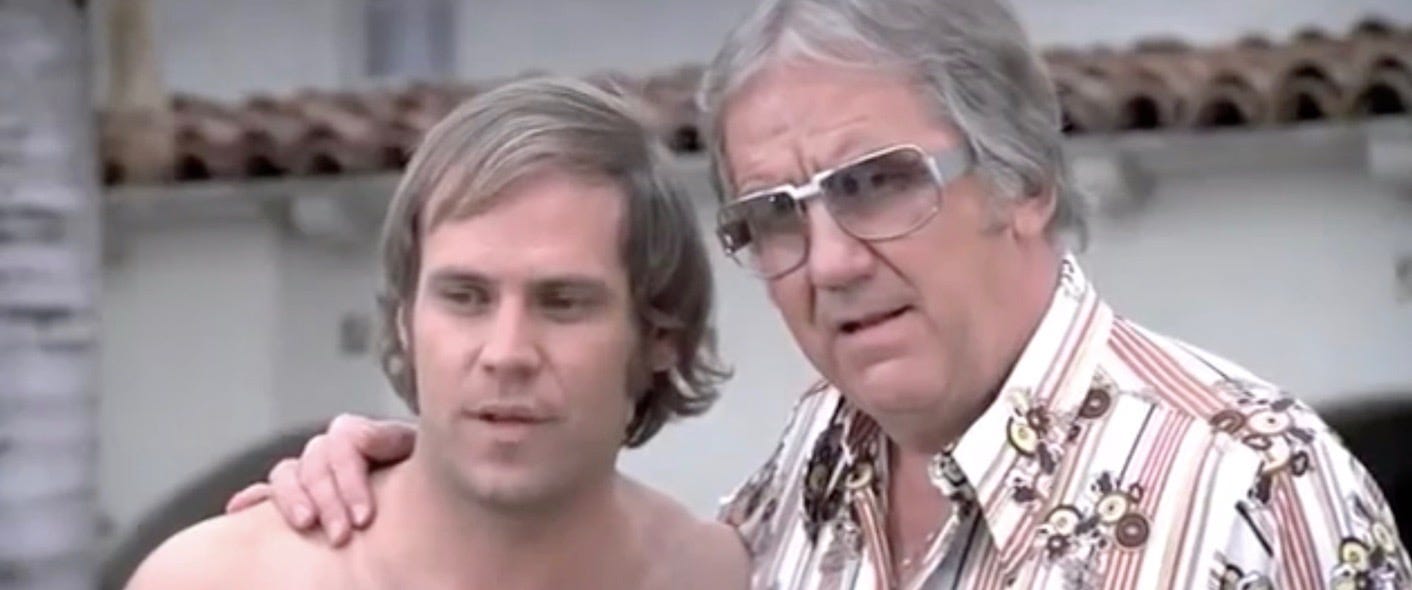
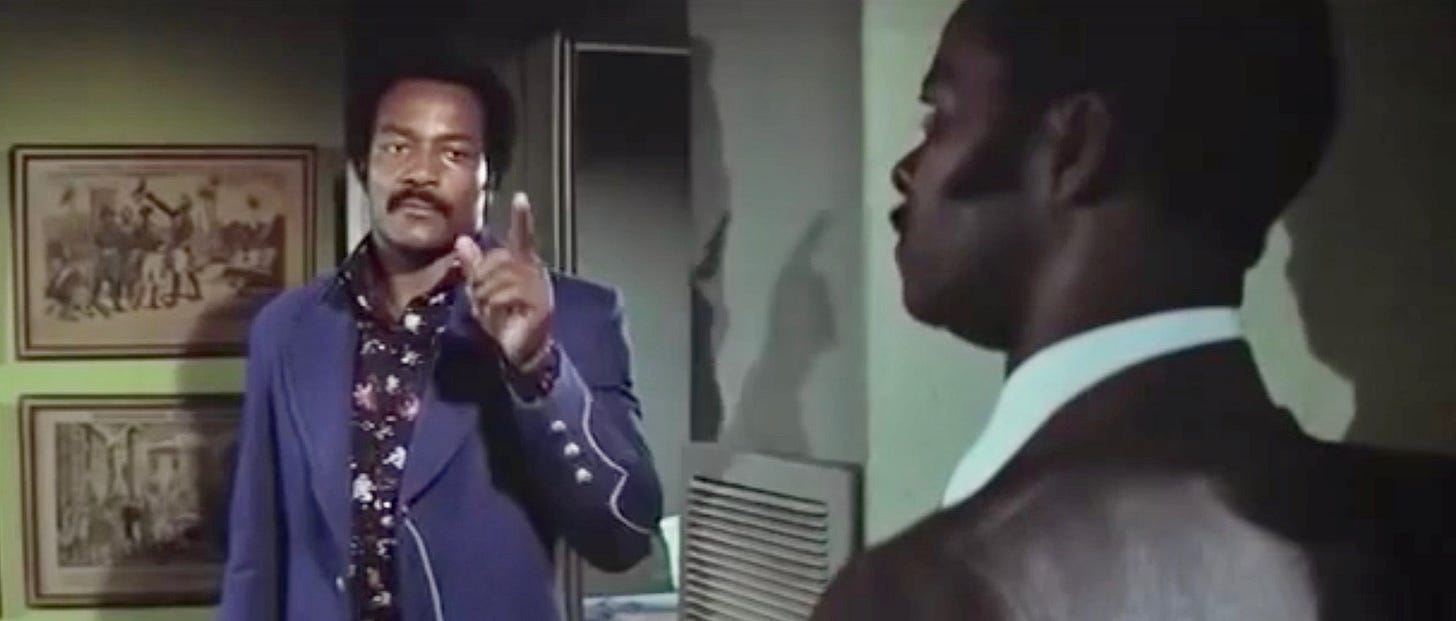
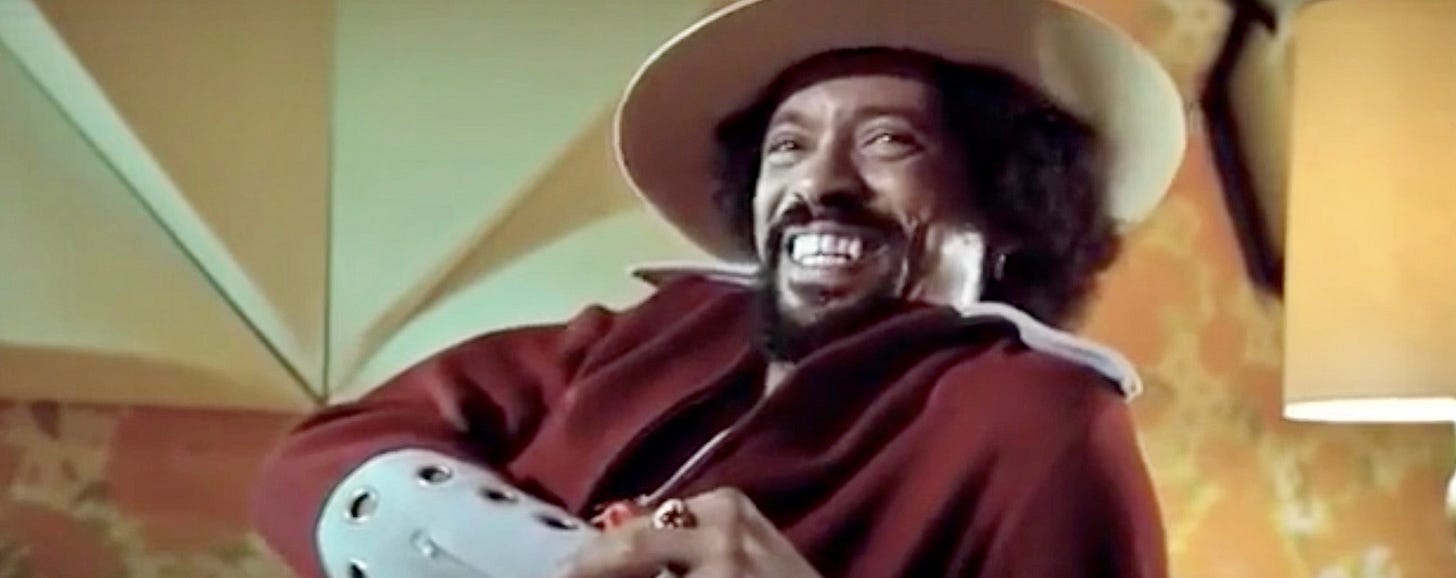

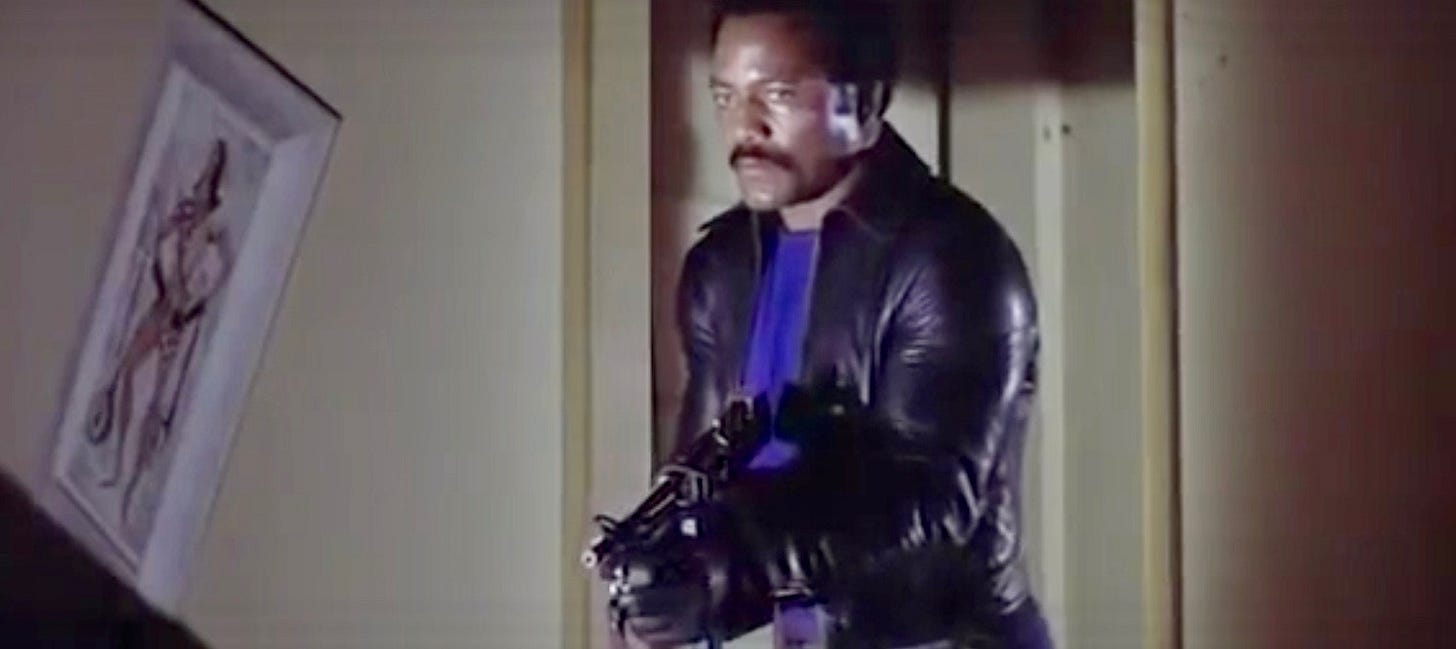
Two famous Browns (Jim and James) associated with one movie; although I'm more familiar with Brown's work for "Black Caesar", I might just check out the "Big Rip-Off" soundtrack. Especially since you clearly believe it belies its title.